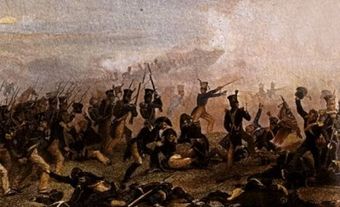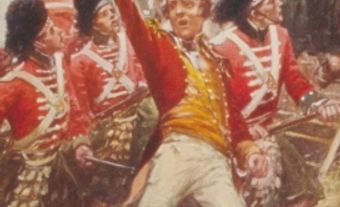The Battle of the Thames (sometimes called the Battle of Moraviantown) occurred 5 October 1813, during the War of 1812. Following the American naval victory under Captain Oliver H. Perry in the battle on Lake Erie at Put-in-Bay on 10 September 1813, the entire western peninsula of Upper Canada was in danger of falling into enemy hands. Major General Henry Procter, who commanded all British and Canadian forces west of Burlington, was short of supplies and decided to retreat up the River Thames.
Tecumseh's Objections
The Shawnee war chief Tecumseh contested the decision; his warriors were hesitant to retreat and were eager for combat against the despised Americans. Tecumseh soon questioned the willingness of the British to face the Americans with decisive action, fearing their ally would eventually betray the trust of the First Nations as they had in the past. Tecumseh held grave concerns that a weak retreat would leave the Aboriginal settlements west of Detroit at risk, so this American incursion needed to be confronted, not abandoned. Proctor managed to persuade the Natives to follow his lead, promising he would make a stand before they made way to connect with Major General Vincent's forces. Proctor had roughly 900 men under his command, a sizable force he was not adept at wielding, as well as approximately 500 warriors under Tecumseh. The retreat began on 27 Sep 1813.
The American Assault
The Americans launched an assault and landed at Amherstburg, under the command of Major General William Henry Harrison, a future president of the United States, in late September, and gave a slow chase of the retreating British. They were soon joined by 500 mounted riflemen and Kentucky volunteers. Luckily for the British, Harrison was a cautious general who did not press hard to catch up with his foe. Luckily for the Americans, Proctor was both a slow and uninspired leader who did little to obstruct the American advance, failing to destroy bridges and other access points. Worse, Procter's command of battle tactics was soon tested and found wanting.
Procter's Stand at Moraviantown
After a slow and disorderly withdrawal, Procter took his stand near Moraviantown. The tired and dispirited British line broke early in the battle. They had a single 6-pounder artillery piece, but no ammunition. Still, they prepared for battle. The Aboriginals lay in the swamp to the British's right, and Tecumseh rode by the British line of soldiers, shaking hands with each man before the battle took shape.
Harrison concentrated his men in a centre column, with the Kentucky mounted riflemen riding hard and charging from the woods to discourage the British, who broke apart before they could deliver a deadly volley and soon were firing only scattered fire. As the British surrendered, the mounted US soldiers dismounted to confront the warriors in the swamp, meeting stiff resistance.
The Death of Tecumseh
As the battle in the swamp waged, Tecumseh was wounded and killed, as was the warrior chief Stiahta (also known as Stayeghtha and Roundhead), of the Wyandot people. Without their stout and capable leaders, the Aboriginal will to resist the very capable American soldiers was depleted, and retreat was more palatable. Proctor led the retreat after the battle.
Some 246 British soldiers escaped and retreated to the head of Lake Ontario, leaving behind 606 killed or captured. An estimated 33 Aboriginals were killed, their bodies taken with the retreating survivors. American losses stood at 7 killed, and 22 wounded. Harrison told US Secretary of War John Armstrong, Jr. that all his casualties were a result of the Aboriginal warriors, not the British regulars. Unable to sustain or build on his victory, Harrison and his men headed for Detroit, the Americans now in firm control of the North West frontier. Procter would continue to command those who had fought with him, but his poor handling of the retreat and battle would be his undoing.
Consequences of the Battle of Moraviantown
To the First Nations, Procter's actions confirmed their worst fears about the lack of resolution and commitment by their longtime ally, King George III. Internally, their coalition would not survive the deaths of Tecumseh and Stiahta, whose leadership, skill and presence were critical to cohesion between the tribes. Harrison would soon sign peace agreements with various tribes, in a move to divide and nullify Britain's chief ally. Most of the prisoners the Americans took ended up interned at an encampment in Sandusky, Ohio, suffering severe sickness in captivity. Relegated to menial commands for the rest of the war, Procter's military career was soon over. In May 1814, he was charged with negligence and improper conduct. His court martial, delayed due to operational reasons, was held in December. The judge chastised him for the conduct of his retreat, and suspended Procter from rank and pay for six months. He never held a senior command again.

 Share on Facebook
Share on Facebook Share on X
Share on X Share by Email
Share by Email Share on Google Classroom
Share on Google Classroom





